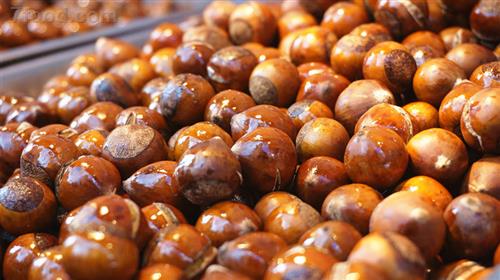Chestnut, also known as chestnut, chestnut, chestnut, and wind chestnut, is a genus of the genus Castanea, native to China. Do you usually eat chestnuts? Do you know the nutritional benefits of chestnuts? The nutritional value of chestnut Each 100 grams contains 5.7 grams of protein, 2 grams of fat, 40 to 45 grams of carbohydrate, and 25 grams of starch. The Vitamin content of raw chestnuts can be as high as 40 to 60 milligrams, and the content of cooked chestnut vitamins is approximately 25 milligrams. Chestnuts also contain calcium, phosphorus, iron, potassium and other inorganic salts and carotene, B vitamins and other ingredients. 1. Rich in unsaturated fatty acids and vitamins and minerals contained in chestnuts can prevent and treat diseases such as hypertension, coronary heart disease, arteriosclerosis, osteoporosis, etc. It is a tonic for Anti-Aging and longevity. 2, chestnuts contain riboflavin, eat chestnuts for long-term refractory children's tongue sores and adult oral ulcers beneficial 3. Chestnut is a dried fruit variety with a high carbohydrate content. It can supply the body with more heat energy and can help fat metabolism. It has the function of strengthening Qi and strengthening the spleen and strengthening the gastrointestinal function. 4, chestnuts are rich in vitamin C, can maintain the normal function of teeth, bones, vascular muscles, can prevent and treat osteoporosis, lumbar and leg muscles, bones, pain, fatigue, etc., delay human aging, is the ideal health care products for the elderly . Chestnut peeling method Hot water immersion method We washed the raw chestnut and placed it in the pan. Add some salt and put some hot water to soak for a while. After about 5 minutes, take out the chestnuts. The chestnut skin will soon fall. Refrigerator freezing method After the chestnuts have been cooked and cooled, they are frozen in the freezer for two hours, so that the chestnuts are peeled off and the chestnuts are intact. Microwave heating The raw chestnuts that will be bought are cut out with scissors and heated in a microwave oven for 30 seconds at a high temperature. The endothelium and chestnuts are automatically detached. Before using this method to remove the endothelium, be sure to cut the shell, otherwise it may cause the microwave oven to malfunction. Sun exposure method Place the raw chestnuts in the sun for a day and the chestnut shell will crack. At this time, the shell and the endothelium of the chestnut can be easily peeled off whether it is peeled or peeled after cooking. However, the chestnuts that are prepared for storage cannot be used because the dried chestnuts cannot be stored for a long time. Thermal expansion and contraction Put the chestnut in boiling water for a few minutes, then take it out and put it in the cold water for a few minutes to make it easy. Chopsticks stirring method First, place all the chestnuts in two, put them in the bowl and put them in the pot. After adding boiling water for a while, stir it with chopsticks. The skin of the chestnuts will be separated from the chestnuts. Now everybody does not want to marry how to peel the chestnuts off, and use hot water to scald just fine. Isn't it simple? Just find a way quickly. Chestnuts also have the benefit of Qi and spleen. Vitamin Vitamins are a type of trace organic substances that humans and animals must obtain from food in order to maintain normal physiological functions. In terms of physiological functions, vitamins are neither a raw material for tissues nor a substance for supplying energy, but they are an indispensable substance for the body. It has many types and different chemical structures. Most of them are the components of the coenzyme (or prosthetic group) of certain enzymes. They are the indispensable compounds for maintaining the normal growth (growth, health, reproduction and production function) of the body. It plays a catalytic role in the body to promote the synthesis and degradation of major nutrients (proteins, fats, carbohydrates, etc.), thereby controlling metabolism. Vitamins are essentially low-molecular organic compounds. They cannot be synthesized in the body, or the amount synthesized is difficult to meet the needs of the body, so they must be supplied from the outside. The daily requirement of vitamins is very small (usually measured in milligrams or micrograms). They are neither a raw material for body tissues nor a substance for energy supply in the body. However, they do not regulate material metabolism, promote growth and development, and maintain physiological functions. Vitamin K2 MK-7, Vitamin C, Vitamin E, Vitamin K2, Vitamin H, Vitamin D3 Xi'an Gawen Biotechnology Co., Ltd , https://www.ahualyn-bios.com
Chestnut nutritional value and peeling method